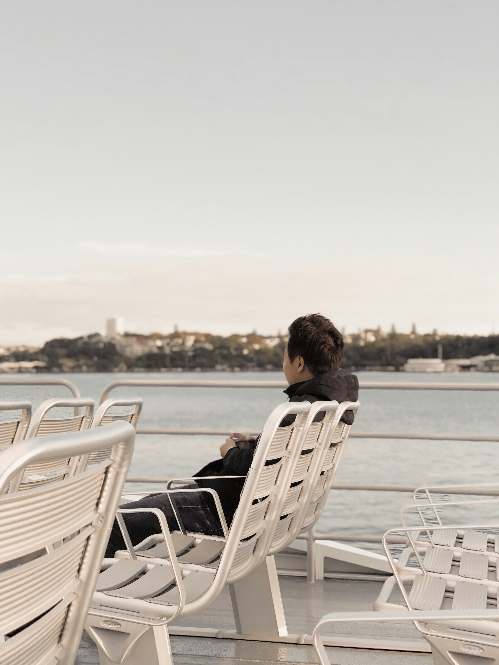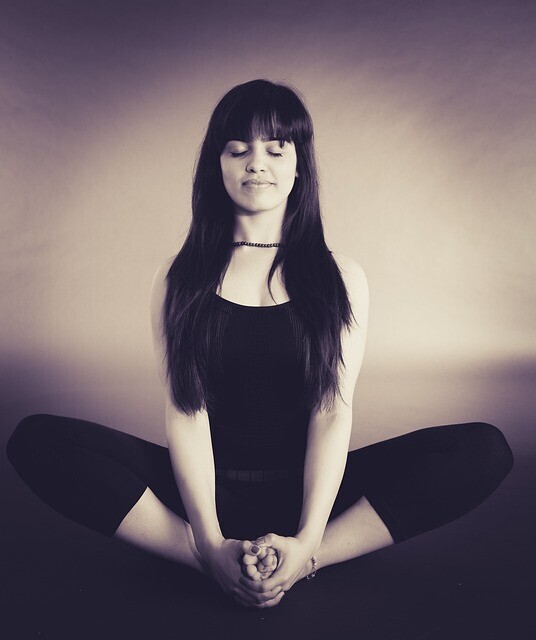Chapter 2: Getting Started with
Meditation
Creating a Sacred Space for Meditation
Creating a Sacred Space for Meditation is crucial for parents and caregivers looking to nd serenity and relief from stress through meditation. This space should be a peaceful and tranquil environment where you can escape from the chaos of daily life and connect with your inner self.
Finding Serenity: A Parent's Guide to Stress Relief through Meditation
Page 10

Start by choosing a quiet and clutter-free area in your home where you can meditate without distractions. This could be a corner of your bedroom, a cozy nook in the living room, or even a spot in your backyard. Make sure the space is clean and organized, with minimal decorations that promote a sense of calm and serenity.
Consider adding elements that enhance
the sacredness of the space, such as
candles, incense, crystals, or plants.
These items can help create a soothing
atmosphere and set the mood for
meditation. You may also want to include
meaningful objects like pictures of loved
ones, inspirational quotes, or spiritual
symbols that hold personal signi cance
for you.
Invest in comfortable cushions, blankets,
or a meditation chair to support your
posture and help you relax during your
practice. You may also want to play soft
music or nature sounds to further enhance the ambiance of your sacred space.
By creating a dedicated area for meditation, you are setting the intention to prioritize your mental and emotional well-being. This space serves as a reminder to make time for self-care and allows you to retreat from the busyness of life to focus on your inner peace and clarity. Take the time to personalize and cultivate your sacred space for meditation, and watch as it becomes a sanctuary for relaxation and rejuvenation in your daily routine.
Finding Serenity: A Parent's Guide to Stress Relief through Meditation
Page 11

Choosing the Right Meditation Techniques
Choosing the right meditation techniques can be a crucial step in nding serenity and stress relief as a parent or caregiver. With so many di erent methods and practices available, it can be overwhelming to determine which one is best suited for your needs. In this subchapter, we will explore some key factors to consider when selecting the right meditation techniques for you.
Another misconception about meditation is that it needs to be performed in some type of sitting "lotus" position. It is understandable that someone would think this. It is very common to see pictures of people meditating in this position.
The reality is quite di erent. It is perfectly acceptable to perform a meditation session sitting upright in a chair, lying down (on your back) or even in a standing position. The key is to be as comfortable as possible. For meditation to be e ective, only requires you to be relaxed and in a comfortable position.
Finding Serenity: A Parent's Guide to Stress Relief through Meditation
Page 12

The more often you meditate, the more quickly you will begin to nd an inner sense of what works for you. Meditation is a very personal experience and it is not the same for everyone.
Case in point, I have often found myself standing in a long line, picked a point to focus on and simply began to enter into a meditative state. I have even done this sitting in tra c in my car (with my eyes open of course). The point being, anywhere you nd you have a few moments to yourself is a good time to meditate. It is not about your position, but about achieving clarity, even if only for a few minutes at a time.
Next, it is important to identify your speci c goals and intentions for practicing meditation. Are you looking to reduce stress, improve focus, or cultivate a sense of inner peace? Di erent techniques may be more e ective for achieving certain outcomes, so it's essential to have a clear understanding of what you hope to gain from your meditation practice.
Consider your personal preferences and
lifestyle. Some meditation techniques,
such as mindfulness or loving-kindness
meditation, can be practiced anywhere
and at any time, making them ideal for
busy parents and caregivers. Others, like
guided visualization or body scan
meditation, may require a quiet and
comfortable space to fully engage with
the practice. Choose a technique that
aligns with your schedule and environment to ensure consistency and success in your meditation practice.
Finding Serenity: A Parent's Guide to Stress Relief through Meditation
Page 13
Lastly, don't be afraid to experiment with di erent techniques and approaches to meditation. What works for one person may not work for another, so it's important to explore a variety of practices to nd what resonates most with you. Remember, the goal of meditation is not perfection but rather progress and growth. Trust your instincts, be patient with yourself, and enjoy the journey of discovering the right meditation techniques that bring you peace and serenity as a parent or caregiver.
It is more important to cultivate a sense of calm and peacefulness from within than it is to be concerned with the proper "mechanics" such as positioning or slowing your breathe. These things will come naturally to you and with time and practice they will happen on a subconscious level without needing to pay attention to it.
Keep in mind that meditation is a natural process that takes place internally. We are all programmed to connect with our subconscious as an integral part of our primal makeup. Meditation is as much a natural part of us as eating and breathing are. It is not an abstract process, but one that we are perfectly in tuned to.
Your subconscious and your intuition are always working towards the most bene cial outcomes for you. The fact that we have lost touch with this powerful does not change the fact that it is always there and always working to achieve the best outcome for each of us.
Remember that the goal of meditation is not to control your thoughts. . It's to stop letting them control you.
""The mind is everything, what you think, you become."
-- Buddha
Finding Serenity: A Parent's Guide to Stress Relief through Meditation
Page 14
Establishing a Daily Meditation Practice It's a fast-paced world, it can be challenging for parents and caregivers to nd moments of peace and serenity amidst their busy schedules. However, incorporating a daily meditation practice into your routine can be a game-changer when it comes to managing stress and nding inner peace.
You can start by setting aside a speci c time each day for meditation. Whether it's rst thing in the morning, during a lunch break, or right before bed, consistency is key to building a lasting habit. Consider creating a dedicated meditation space in your home where you can retreat and focus on your practice without distractions.
When beginning your meditation practic ,
e it's normal to feel restless or nd it di cult to quiet your mind. Remember that meditation is a skill that takes devleops over time, so be patient with yourself and allow yourself to gradually ease into the practice. Start with just a few minutes each day and gradually increase the duration as you become more comfortable.
Experiment with di erent meditation techniques to nd what works best for you.
Whether it's mindfulness meditation, loving-kindness meditation, or guided visualization, there are countless methods to choose from. Find one that resonates with you and brings you a sense of calm and clarity.
As you establish a daily meditation practice, pay attention to the positive e ects it has on your overall well-being. Notice how you feel more centered, focused, and resilient in the face of challenges. By prioritizing your mental and emotional health through meditation, you'll be better equipped to navigate the ups and downs of parenting with grace and ease.
Finding Serenity: A Parent's Guide to Stress Relief through Meditation
Page 15
Chapter 3: Mindfulness Meditation for Stress Relief
Practicing Mindfulness in Everyday Activities
It can be easy to get caught up in the chaos of everyday life. However, nding moments of mindfulness in our daily activities can be a powerful tool for managing stress and cultivating inner peace.
Practicing mindfulness in everyday activities involves being fully present and aware of your thoughts, feelings, and surroundings. It's about slowing down and paying attention to the present moment without judgment. As you do this you begin to feel more grounded, reduce anxiety, and improve your overall physical and emotional well-being.
One simple way to practice mindfulness in everyday activities is to bring your attention to your breath. Take a few deep breaths and notice the sensation of air entering and leaving your body. This can help calm your mind and bring you back to the present moment.
Finding Serenity: A Parent's Guide to Stress Relief through Meditation
Page 16

Another way to incorporate
mindfulness into your daily
routine is to focus on the task at
hand. Whether you're washing
dishes, folding laundry, or playing
with your child, try to give your
full attention to the activity. Notice
the sights, sounds, and sensations
around you without getting
caught up in distractions or
worries about the future.
By practicing mindfulness in everyday activities, you can
create moments of peace and
tranquility in the midst of a busy day. This can help you feel more centered, reduce stress, and improve your ability to respond to challenges with patience and clarity.
Incorporating mindfulness practices into your daily routine can have a profound impact on your overall well-being. By nding moments of mindfulness in everyday activities, you can cultivate a sense of calm and serenity that will bene t both you and your family.
Finding Serenity: A Parent's Guide to Stress Relief through Meditation
Page 17
Breathing Exercises for Relaxation Parents and caregivers often nd themselves overwhelmed with the demands of daily life. From juggling work and family responsibilities to managing household chores and children's schedules, it's easy to feel stressed and anxious for seemingly no obvious reason at all. However, nding moments of calm and relaxation is crucial for maintaining your overall physical health and mental well-being. One e ective way to reduce stress and promote inner peace is through breathing exercises.
Breathing exercises are simple techniques that can help you calm your mind, relax your body, and center your thoughts. When focusing on your breath, you can bring your attention to the present moment and let go of worries and distractions. These exercises are especially bene cial when nding yourself constantly multitasking and feeling overwhelmed.
One Ancient Doaist Meditation technique is called "skin breating." This method is performed by picturing youself as similar to a balloon. When breating inward, lling your lungs with air, you envision yourself in ating a ballon. As you start to exhale you would envision and maintain an image of dedlating the balloon. The reason it is called "skin breating," is because you are beathing into your skin, cells, tissue and organs and exhaling outward, de ating the balloon and expelling the toxins, stress and negativity through the pores of the skin.
This can be done in a very short amount of time and if you choose to try it, you will nd it to be extremely relaxing, cleansing and bene cial.
Finding Serenity: A Parent's Guide to Stress Relief through Meditation
Page 18

Finding Serenity: A Parent's Guide to Stress Relief through Meditation
Page 19

Another e ective breathing exercise for relaxation is deep diaphragmatic breathing.
Start by sitting or lying down in a comfortable position. Place one hand on your chest and the other on your abdomen. Take a slow, deep breath in through your nose, feeling your abdomen rise as you ll your lungs with air. Then, exhale slowly through your mouth, feeling your abdomen fall as you release the breath. Repeat this process for several minutes, focusing on the sensation of your breath moving in and out of your body.
Another helpful breathing exercise is
alternate nostril breathing. This technique
involves breathing in through one nostril
and out through the other, alternating
between the two. This practice can help
balance the ow of energy in your body
and promote a deep sense of calm and
relaxation.
Incorporating these breathing exercises
into your daily routine can help you nd
moments of peace and tranquility amidst
the chaos of parenthood. By taking the time
to focus on your breath and quiet your
mind, you can reduce stress, improve your
mood, and cultivate a deeper sense of
inner peace.
Finding Serenity: A Parent's Guide to Stress Relief through Meditation
Page 20
Cultivating Gratitude and Positive Thinking Taking the time to cultivate gratitude and positive thinking can have a profound impact on your overall mental health and well-being. In this chapter, we will explore how practicing gratitude and positive thinking can help you nd serenity.
Gratitude is a powerful tool that can shift your focus from what is lacking in your life to what you already have. Taking the time to re ect on the things you are grateful for, you can increase your overall sense of well-being and happiness. One simple way to cultivate gratitude is to keep a gratitude journal. Each day, take a few minutes to write down three things you are grateful for. This practice can help you shift your mindset from one of scarcity to one of abundance.
Positive thinking is another key component of nding serenity as a parent. By focusing on the positive aspects of your life, you can reduce stress and increase feelings of happiness and contentment. One way to practice positive thinking is to challenge negative thoughts and replace them with positive a rmations. For example, if you nd yourself thinking "I'm not a good parent," challenge that thought by reminding yourself of all the ways you show love and care for your loved ones.
By cultivating gratitude and positive thinking, you can create a more peaceful and harmonious home environment for both yourself and your family. Taking the time to practice these techniques can help you navigate the challenges of parenthood with grace and ease. Remember, nding serenity is a journey, and by incorporating these practices into your daily routine, you are on a path that will bring peace and joy into your life and those around you.
Finding Serenity: A Parent's Guide to Stress Relief through Meditation
Page 21
Chapter 4: Guided Visualization for Relaxation
Using Visualization to Release Stress and Anxiety Stress and anxiety can easily build up, leaving us feeling overwhelmed and exhausted. One powerful tool that can help release stress and anxiety is visualization. By using visualization techniques, you can begin to experience almost immediate sense of calm, deep bodily relaxation and create an inner serenity in the midst of chaos.
Visualization involves creating mental images of peaceful and calming scenes or experiences. By focusing on these positive images, we can shift our attention away from stressful thoughts and emotions, allowing them to relax and unwind.
Visualization can be done anywhere, at any time, making it a convenient and e ective tool regardless of how busy you may be.
To practice visualization, nd a quiet and comfortable space where you can sit or lie down. Close your eyes and take a few deep breaths to center yourself. Then imagine yourself in a peaceful and serene place, such as a beautiful beach, a lush forest, or a quiet meadow or perhaps abeautiful waterfall. Picture yourself surrounded by beauty and tranquility, feeling calm and at ease.
Finding Serenity: A Parent's Guide to Stress Relief through Meditation
Page 22

As you visualize this scene, focus on all of your senses – the sights, sounds, smells, and sensations of your peaceful surroundings. Allow yourself to fully immerse in the experience, letting go of any stress or tension you may be holding onto. Stay in this visualization for as long as you need, letting it wash away your worries and restore your sense of inner peace.
If you nd that your mind begins to wander, that is perfectly normal at times. It takes practice to quiet the mind. When you notice your thoughts beginning to drift, gently bring them back to your original point of focus. Do not try to force this as it is a very normal and natural occurance.
Visualization is a very e ective method of releasing stress and anxiety and maintaining a sense of calm and well-being. Remember to practice regularly
and be patient with yourself as you learn to
harness the power of visualization.
Creating Your Own Guided
Meditation Scripts
As parents and caregivers, nding moments of peace and serenity can be a challenge amidst the hectic daily schedule. Meditation is a powerful tool that can help you nd that inner calm and release stress. Another way to enhance your meditation practice is by creating your own guided meditation scripts tailored to your speci c needs and desires.
Finding Serenity: A Parent's Guide to Stress Relief through Meditation
Page 23
To start creating your own guided meditation scripts, begin by nding a quiet and comfortable space where you can relax and focus. Take a few deep breaths to center yourself and clear your mind. Think about what you want to achieve through your meditation practice - let everything else around you go. This is your time. You not only owe it to yourself, but you deserve it.
Next, consider the elements you want to include in your guided meditation script.
This could be visualizations, a rmations, or soothing music. You can also incorporate breathing techniques or body scan exercises to help you relax and connect with your body.
When writing your script, keep it simple and easy to follow. Use calming language and imagery to guide yourself through the meditation process. Focus on creating a sense of relaxation and mindfulness throughout the script.
Remember that your guided meditation script is a re ection of your own unique journey towards inner peace. Be open to exploring di erent techniques and styles to nd what resonates with you. You can also draw inspiration from existing guided meditation scripts or resources to help you develop your own.
By creating your own guided meditation scripts, you are taking a proactive step towards nding serenity and relieving stress in your everyday life. Embrace this opportunity to connect with yourself on a deeper level and cultivate a sense of inner peace that will bene t both you and your loved ones.
Finding Serenity: A Parent's Guide to Stress Relief through Meditation
Page 24
Incorporating Visualization into Your Daily Routine Visualization is a practice where you use mental imagery to create a picture of what you want to achieve or experience. By incorporating visualization into your daily routine, you can reduce stress, increase focus, and cultivate a sense of inner peace.
To begin incorporating visualization into your daily routine, nd a quiet and comfortable space where you can relax without distractions. Close your eyes and take a few deep breaths to center yourself. Then, start to imagine a peaceful scene or a situation where you feel calm and serene. It could be a beach at sunrise, a forest glade, or a cozy replace. Allow yourself to fully immerse in this mental image, focusing on the sights, sounds, and sensations.
As you continue to practice visualization, you may nd that it becomes easier to access this sense of calm and peace throughout your day. You can use visualization techniques to help you manage any stressful situations that may arise, boost your con dence, or simply take a break for a moment of instant relaxation.
By incorporating visualization into your daily routine, you are taking a proactive step towards nding a source of peace that will serve you throughout your life.
Remember, meditation practice is a journey that only requires a small amount of commitment and practice. But because the actual practice of meditaion is relatively simple to do, do not make the mistake of thinking, "it's so simplistic, how could it work?"
Finding Serenity: A Parent's Guide to Stress Relief through Meditation
Page 25
You will nd the bene ts of your practice to be both enormous and life-changing.
By incorporating visualization into your daily routine you are giving yourself a powerful tool to help you navigate life's challenges with ease and con dence.
Embrace this hidden power of visualization within you and watch as it transforms your daily life,










